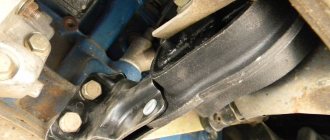An automatic transmission consists of numerous moving parts that operate in an oil environment. A special transmission fluid lubricates and removes heat from the metal rubbing surfaces of the automatic transmission. At negative ambient temperatures, the technical and operational characteristics of the working fluid deteriorate significantly. To avoid premature wear of transmission parts and components, it is necessary to properly warm up the automatic transmission in winter.
Features of operating an automatic transmission in winter
Automakers warn that it is necessary to warm up a car with an automatic transmission in winter before driving. There are several opposing opinions about whether it is necessary to warm up the automatic transmission in winter. Among experienced car owners you can find a variety of answers and recommendations. To draw the right conclusion for yourself and decide whether you need to warm up the automatic transmission in winter, it is recommended:
- become familiar with the design of your vehicle;
- features of the installed automatic transmission;
- study the technical characteristics of the gear oil used;
- remember when the next maintenance was carried out with the replacement of the working fluid and oil filter in the automatic transmission.
When frosts exceed -30°C, a difficult period begins for a car equipped with an automatic transmission. Under such difficult conditions, the working fluid becomes thicker and loses its useful lubricating properties. At the time of cold start-up, the technical characteristics of the transmission oil are significantly reduced. In this case, serious damage to the working units and parts of the automatic transmission is possible. Not only the car’s power unit needs thorough warming up, but also the transmission mechanisms, including the automatic transmission.
Why do you need to warm up an automatic transmission?
The answer to the question “is it necessary to warm up the car automatically” lies in familiarity with the principles, design and operating conditions of the automatic transmission.
Automatic clutch
The task of the transmission is to receive and transmit torque from the engine to the wheels. In a “classic” automatic, the engine power is received by a torque converter, which resembles a donut in an oil environment.
One half of the “donut” - the pump wheel - rotates with engine speed. Centrifugal force throws oil from the blades of the pump wheel onto the blades of the other half, the turbine, causing it to rotate. A reactor is installed between the wheels, which increases the engine torque by 2 - 3 times.
The torque converter absorbs and smoothes out engine vibrations and drives the oil pump, which continuously fills the donut with liquid. The pump also creates pressure in the valve body, which controls the gears. It follows from this that there is no pressure in the automatic transmission before the engine starts. Read
Basic modes and why you need an overdrive button on an automatic machine
The transmission fluid in the automatic machine serves as a working fluid that transmits the moment of force and “serves” the entire structure. That is why it is necessary to warm up the oil, not the lever.
Gear shift
Speeds are switched in a planetary mechanism with friction clutches connected to the turbine through a shaft. When an electronic signal is sent, a certain channel opens in the valve body through which oil passes. Pressure is created on the pistons, the friction discs are tightly compressed, and the planetary gear is braked.
To ensure that the transmission operates at the right time, the clutches and ATF composition are selected individually for each type of automatic transmission. In addition, the liquid lubricates and cools the rubbing elements of the structure.
Conditions for normal operation of automatic transmission
Unlike driving with a manual transmission, comfortable and safe driving with an automatic transmission depends on the quality and quantity of ATF:
| Oil condition | Consequences | Impact on automatic transmission operation |
| Dirty, old, overheated | Viscosity change, sedimentation, low lubricating, anti-corrosion and cooling properties | Fine suspension settles on the filters, the oil pump does not create the required pressure, and the efficiency of the torque converter drops. The clutches do not compress. The box shifts jerkily. The valve body channels become clogged and gear shifting is blocked. The machine overheats due to high friction and fails faster. |
| Underfilling | The pump will suck in air, which will cause the oil to foam. Additives in a diluted liquid lose their properties. | Insufficient pressure on the clutches leads to their slipping. Gears will shift jerkily or jump. Lack of lubrication and cooling will lead to overheating of the automatic transmission, increased load and rapid wear. |
| Overflow | The oil will foam and excess will splash out. The fluid level will drop, resulting in loss of performance. | |
| Mixing different oils or inappropriate composition | Additives are mixed. The chemical reaction is unpredictable. | There is no working pressure, insufficient lubrication and cooling of moving elements. The unit does not work properly and wears out quickly. |
It turns out that changing the properties of ATF leads to wear of the box. Manufacturers select fluid for their transmission based on engine load tolerance, viscosity grade, and type of additives that work under certain conditions. Therefore, in an automatic transmission, the oil must be warmed up in order to stabilize the pressure in the automatic transmission and “start” the operating properties.
How does ATF behave in cold weather?
Proponents of cold starting, who are against warming up the automatic transmission, argue that transmission oil is a unique technological substance that is not afraid of frost, theoretically it should not freeze even at very low temperatures, the fluidity of the material remains constant. In practice, everything looks completely different.
Important: ATP lubricant is made on a synthetic basis and contains numerous additives - additives. However, in severe frost, transmission fluid has increased viscosity, which has a detrimental effect on its properties. This is especially true for oil that is used in the machine without replacement for a long period. It is necessary and even necessary to warm up a box with outdated oil.
Warming up the automatic transmission: all the pros and cons
Let's start with the fact that this issue is controversial. If you study the information on specialized auto forums, some owners strongly recommend warming up the car with an automatic transmission in winter and even in summer, while others claim that there is no need to warm up the automatic transmission.
First, let's figure out what warming up an automatic transmission is. As a rule, preheating the automatic transmission should be understood as turning on each of the automatic modes when the car is standing still, that is, the car is securely held by pressing the brake pedal from jerking or moving forward or backward.
In simple words, the driver starts the engine in mode P, then presses the brake, after which he turns on the available automatic transmission modes one by one (RN, D, 2, 1). In this case, it is recommended to turn on each mode of the machine, lingering on it for an average of 30-60 seconds, and only then move on to the next one.
Also, some car enthusiasts advise staying in R mode for 1-2 minutes in extreme cold, while in other modes you can limit yourself to 15-30 seconds (depending on the outside temperature). The longer delay in “reverse” is dictated by the fact that maximum heat generation in the automatic transmission occurs precisely in reverse mode.
On the one hand, the above actions will inevitably cause increased fuel consumption. However, according to supporters of automatic transmission warming up, this is the only way to achieve a certain dilution and heating of the ATF working fluid before the car starts moving.
- At the same time, opponents of warming up an automatic transmission argue that modern transmission oils and, especially, high-tech synthetic ATF fluid do not change their declared properties even taking into account a significant decrease in temperature.
In other words, the transmission oil in an automatic transmission has all the necessary additives to maintain fluidity and other declared properties. It turns out that the ATF fluid is completely synthetic, it does not freeze and immediately after a cold start the automatic transmission works normally, that is, the transmission is ready for loads, etc.
Opponents also claim that the automatic transmission warms up from the engine, that is, heat is transferred as a result of the operation of the internal combustion engine. Also, switching automatic transmission modes leads to additional wear on the box.
- Now let's figure it out. Let us immediately note that refusal to warm up the machine on the assumption that modern fluid provides all the protective properties is partially justified only if the ATF in the automatic transmission has recently been replaced, and completely.
In practice, taking into account a number of tests and checks, it has been proven that in cold weather ATF, although it does not freeze, thickens, that is, a certain change in viscosity still occurs. At the same time, while the liquid is fresh, in this case the viscosity changes slightly, but if the oil in the box has worked for 30 - 40 thousand km, such ATF begins to thicken noticeably more.
It is not surprising that those who oppose warming up the automatic transmission are, as a rule, the owners of new cars, where the wear of the automatic transmission is minimal and the fluid is fresh. In this case, the operation of the automatic transmission usually does not differ between “cold” and “hot”; the driver does not feel slight jolts when changing gears, etc.
As for more experienced car owners, as a rule, in used cars, if the automatic transmission is not warmed up, you can feel jolts, light kicks, etc. while driving. Moreover, these symptoms disappear after the car has driven 10-15 km, which is enough for the ATF in the automatic transmission to reach operating temperatures.
How to properly warm up a car with automatic transmission in winter
Many car owners trust dealers' promises that their automatic transmission is a maintenance-free unit. According to their beliefs, the characteristics of transmission oil do not change even after long runs of more than 60 thousand kilometers. Such drivers often face the problem of car operation during the winter months. The parts and mechanisms of the automatic transmission also begin to behave inappropriately:
- vibrations, kicking, jolts appear when changing gears;
- gears do not change;
- the oil turns black, foreign fragments appear in its composition in the form of metal shavings, particles of friction linings;
- the oil filter stops performing its functions.
Automatic control during steep climbs and long descents
When driving in difficult conditions, when overcoming a steep climb or when driving on loose snow, the hydromechanical transmission can slip - this is its feature, since there is no rigid connection between the automatic transmission and the engine. In this situation, the driver must help the car by forcibly downshifting in advance.
When driving on a long downhill slope, such as on mountain roads, using only the brake system to prevent dangerous acceleration of the vehicle will result in overheating of the pads, discs or drums. You should forcefully engage the second or even first gear of the automatic transmission to effectively slow down the car.
How to warm up a manual transmission?
No way. Or rather, no additional actions are required from the driver for this: just start the engine. Many will be surprised, but in a manual transmission most of the parts rotate, accelerating the oil even when the car is parked. Unless, of course, the clutch pedal is pressed. The primary shaft and secondary gears rotate. Similar processes occur in a robotic gearbox. And this is quite enough. The fact is that cold work is not as dangerous for the mechanics as in the case of an automatic machine. The main inconvenience for the driver is the difficulty of shifting gears. But here, 5-10 minutes (depending on the temperature outside) of parking with the engine running is enough for the oil to warm up at least a little and the gears to engage without excessive effort.
Our experiment
The measurements were carried out on a previous generation Kia Rio with a 1.6 engine (123 hp) and a 6-speed automatic transmission. Air temperature during testing: -4°C.
The measurements were carried out using the Multitronics C-590 on-board computer. It connects to the OBD-2 diagnostic connector and allows you to determine not only the engine coolant temperature, but also the temperature of the automatic transmission.
The measurements were carried out using the Multitronics C-590 on-board computer. It connects to the OBD-2 diagnostic connector and allows you to determine not only the engine coolant temperature, but also the temperature of the automatic transmission.
Tests have shown: if the machine is in N or P mode, the box warms up very slowly. By the time the engine reaches operating temperature, the machine has barely warmed up. Take a look at the chart.
The engine is warmed up, but what about the gearbox? Dangerous driver misconception
Let's start with the fact that it is still advisable to warm up the engine. Ideally, up to about 60°C, and then go.
But if you can’t wait that long, then the best option is to warm it up for a few minutes and start driving without putting a lot of load on the power unit. While driving (read – under load), any engine warms up noticeably faster than when parked.
What about the gearbox? After all, it also contains oil, and it also thickens in the cold. What to do?











